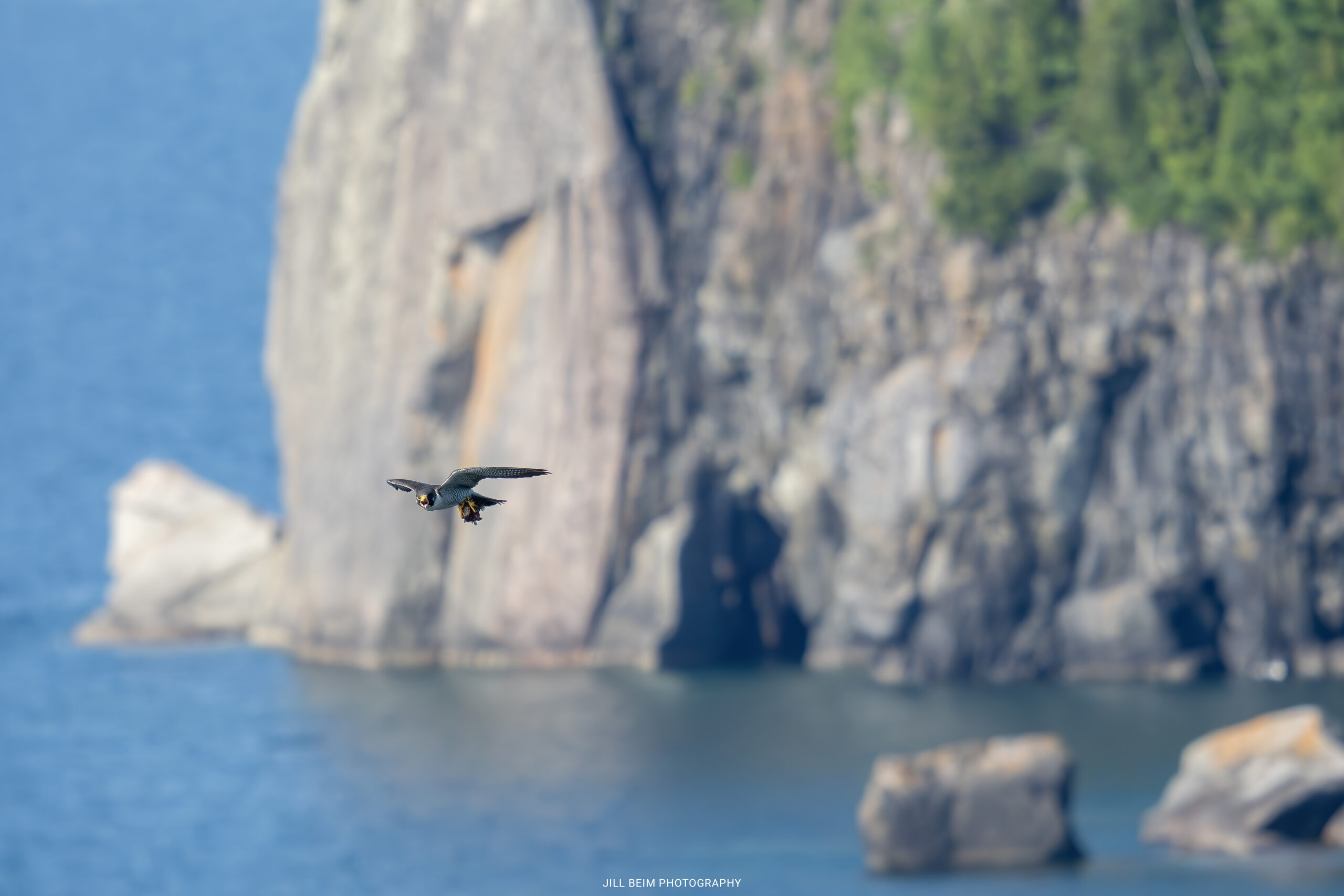A Cliffside Beginning
High on a rocky cliff above Lake Superior, a pair of peregrine falcons welcomes new life into the world. In just 40 days, their tiny, fluffy chicks will grow into fierce young falcons, ready to soar over the lake. Here’s a look at how fast these cliffside raptors grow—and what it takes to become the fastest animal on Earth.
The photos in this timeline were taken at multiple peregrine falcon nests along Lake Superior. They show how peregrine chicks grow over time, though the birds pictured are from different families and nest sites.
** Birds were handled for the purpose of scientific research under a federally authorized Bird Banding Permit issued by the U.S. Geological Survey and in accordance with all state permitting requirements.
Hatching Day: New Life
After 5 weeks of careful incubation, the eggs begin to hatch. A typical peregrine clutch contains 3 to 4 eggs, though sometimes as many as 5. The chicks emerge damp, pink, and fragile—each weighing about as much as 5 or 6 grapes. Their eyes are closed except for a small slit that opens when begging. At this stage, they rely entirely on their parents for warmth and food.
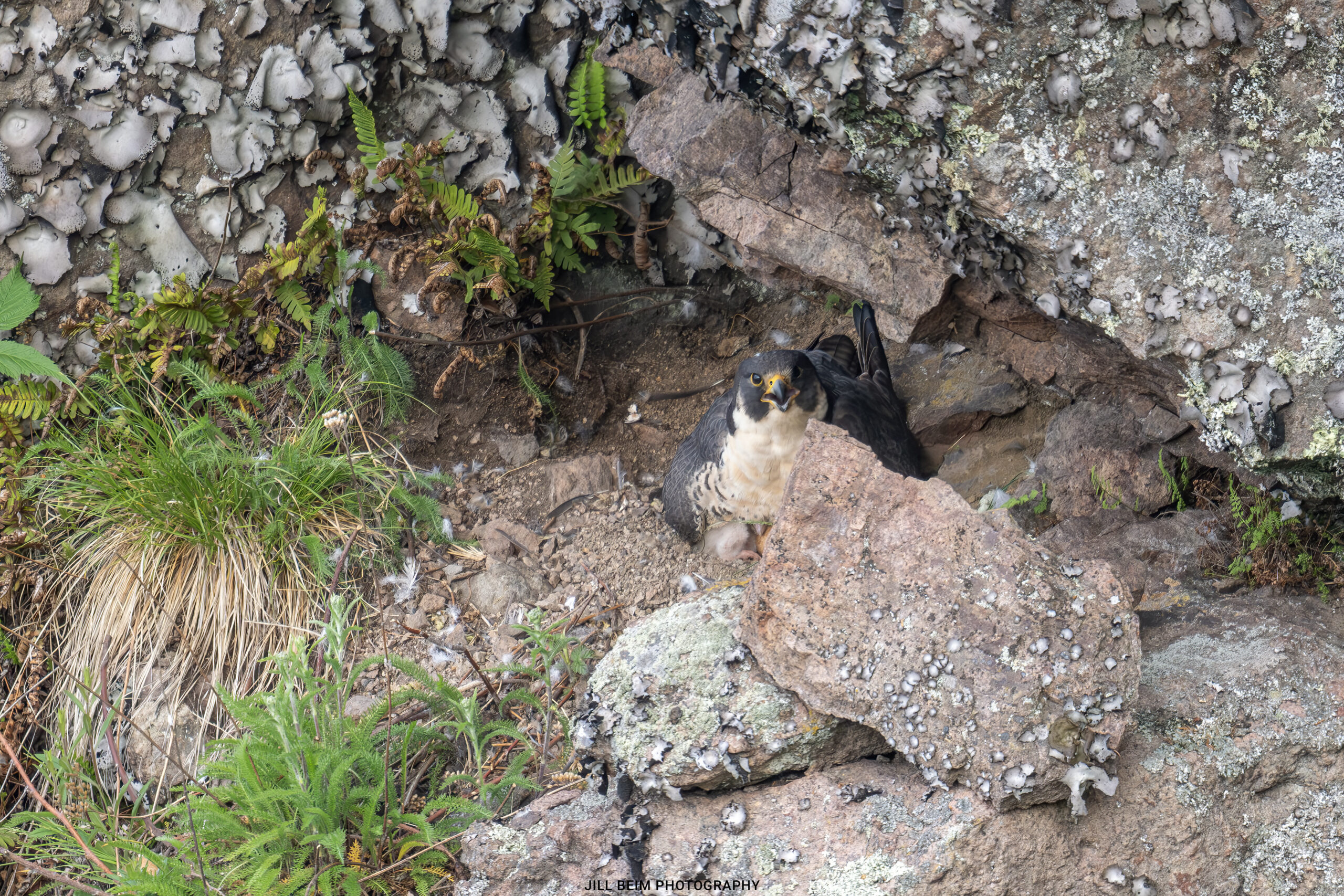
1 Week Old: Growing Fast
In just five days, the chicks—called eyases—have doubled in size. Their eyes are fully open now, and they can sit up—sort of! Around day six, a second layer of fluffy white down begins to appear on their wings.
By one week, the chicks already show noticeable changes. Their down thickens, especially on their wings and backs, though they still huddle together for warmth, often sleeping in a tight group. Around day 13, the feather sheaths for the tail (rectrices) begin to form, though these are not easily visible in the field. More reliable signs for aging appear at about day 14 or 15.
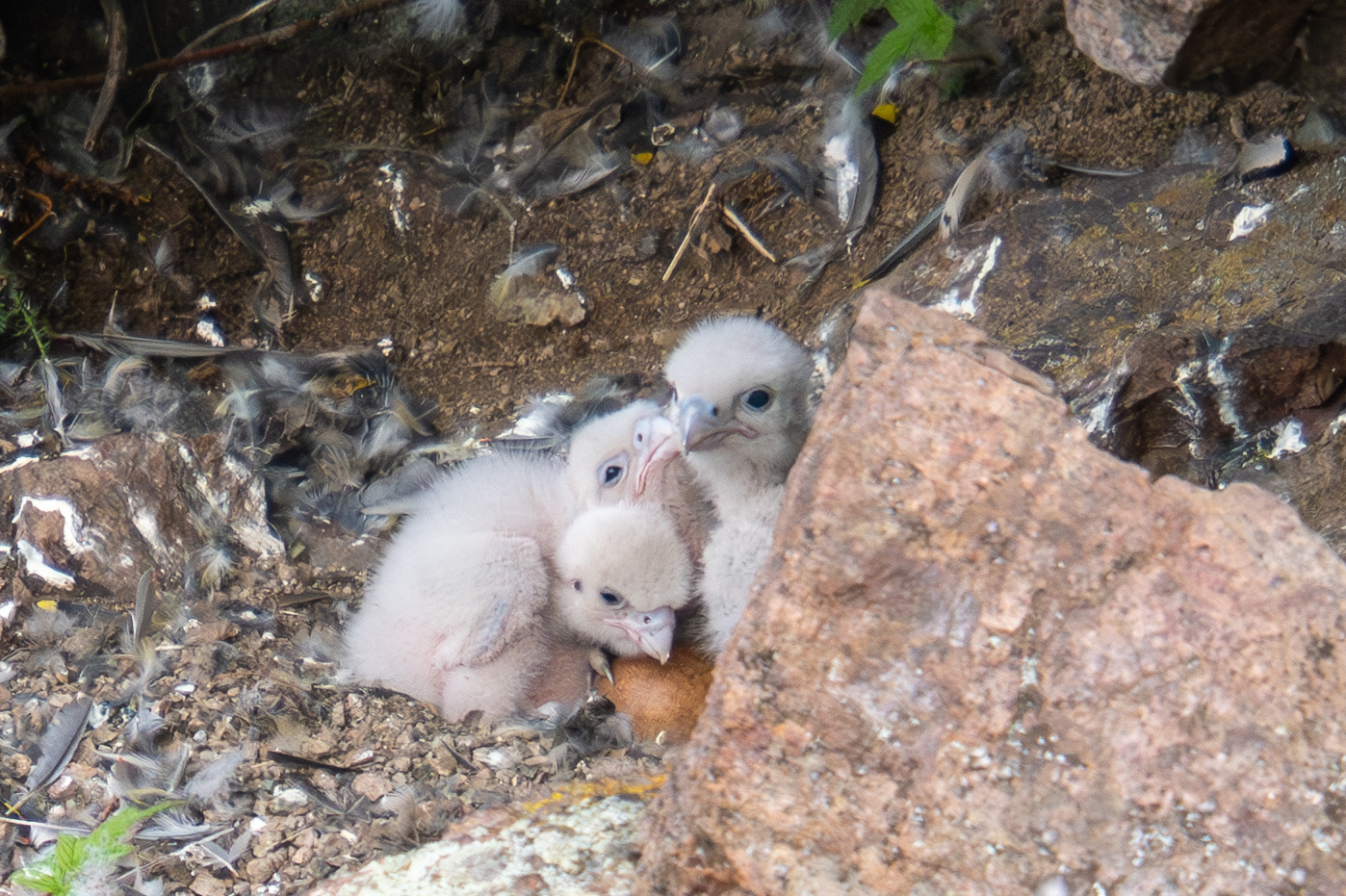
2 Weeks Old: Tarsi Stage
At around two weeks old, peregrine chicks enter the Tarsi Stage. At this point, they begin to waddle around the nest on their tarsi (leg section from toes to heel), exploring their surroundings with a mix of curiosity and clumsy balance. Their down is at peak fluffiness, and the first small feathers begin to push through. Around days 14–15, the primary and tail feathers actually emerge from their protective sheaths. At this point, biologists can estimate a chick’s age by measuring feather growth, which averages about 2 mm per day.
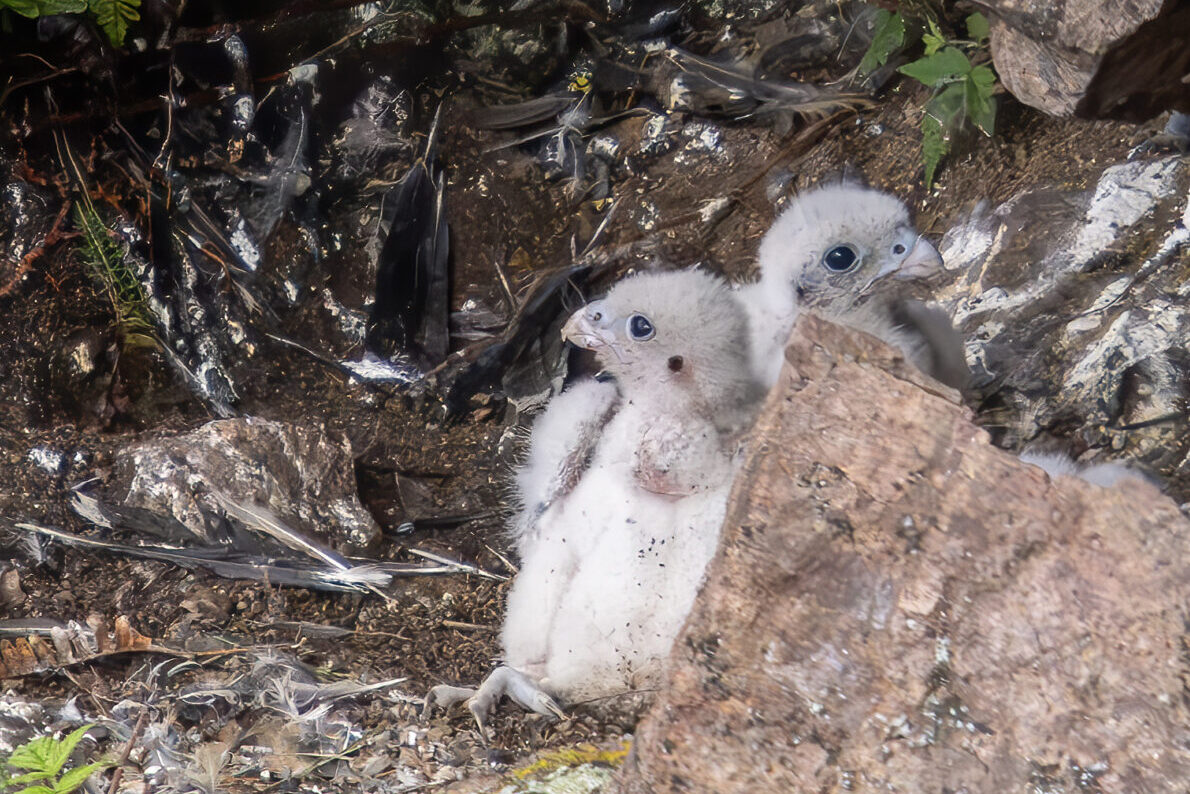
3 Weeks Old: Feather Clues
By three weeks, the chicks’ faces start to resemble adult falcons. Their first dark feathers appear, and their wing and tail feathers grow rapidly. With feather tips now easy to spot, the chicks are more active—moving around on the nest and often sleeping alone instead of in a group.
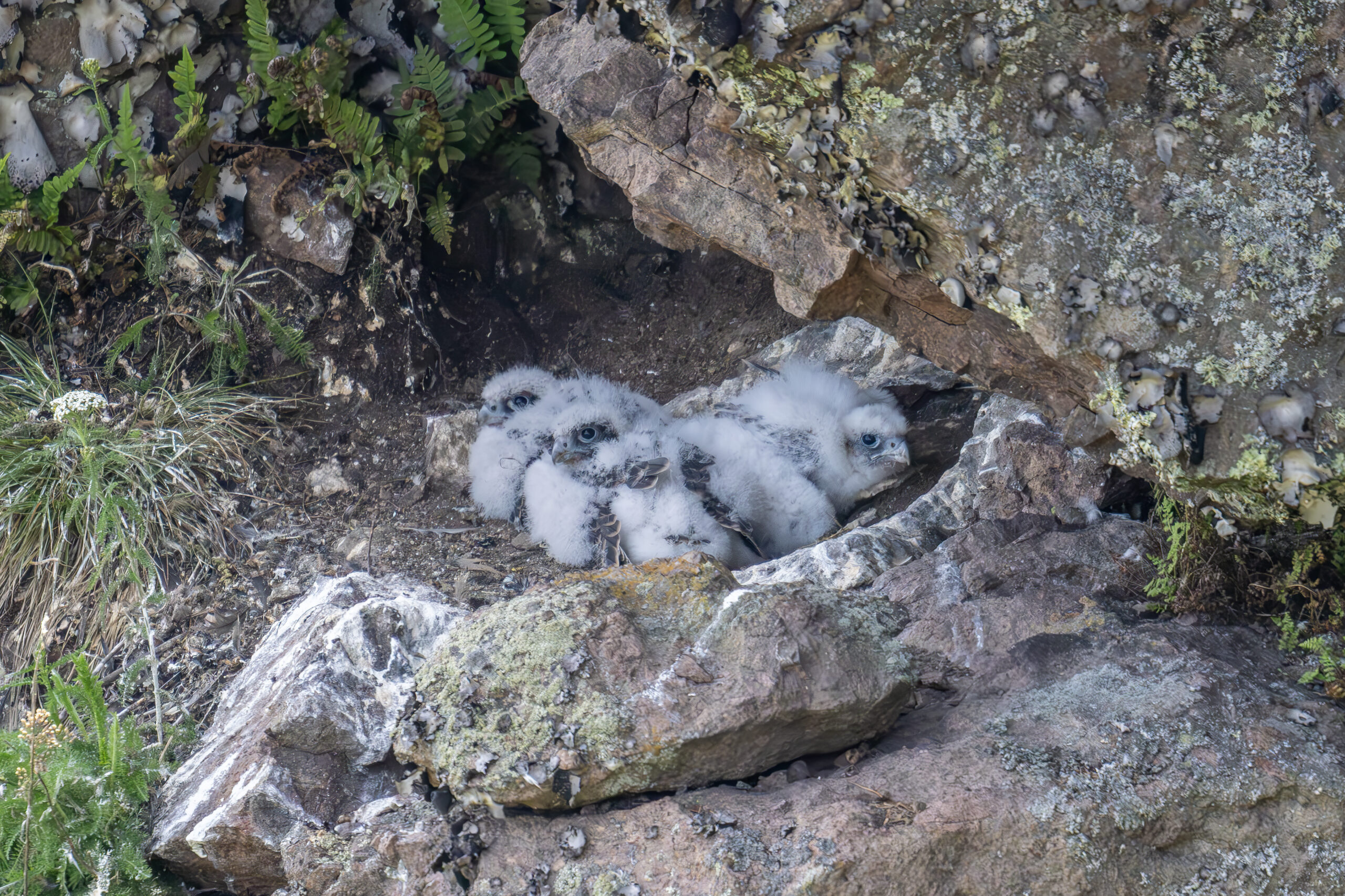
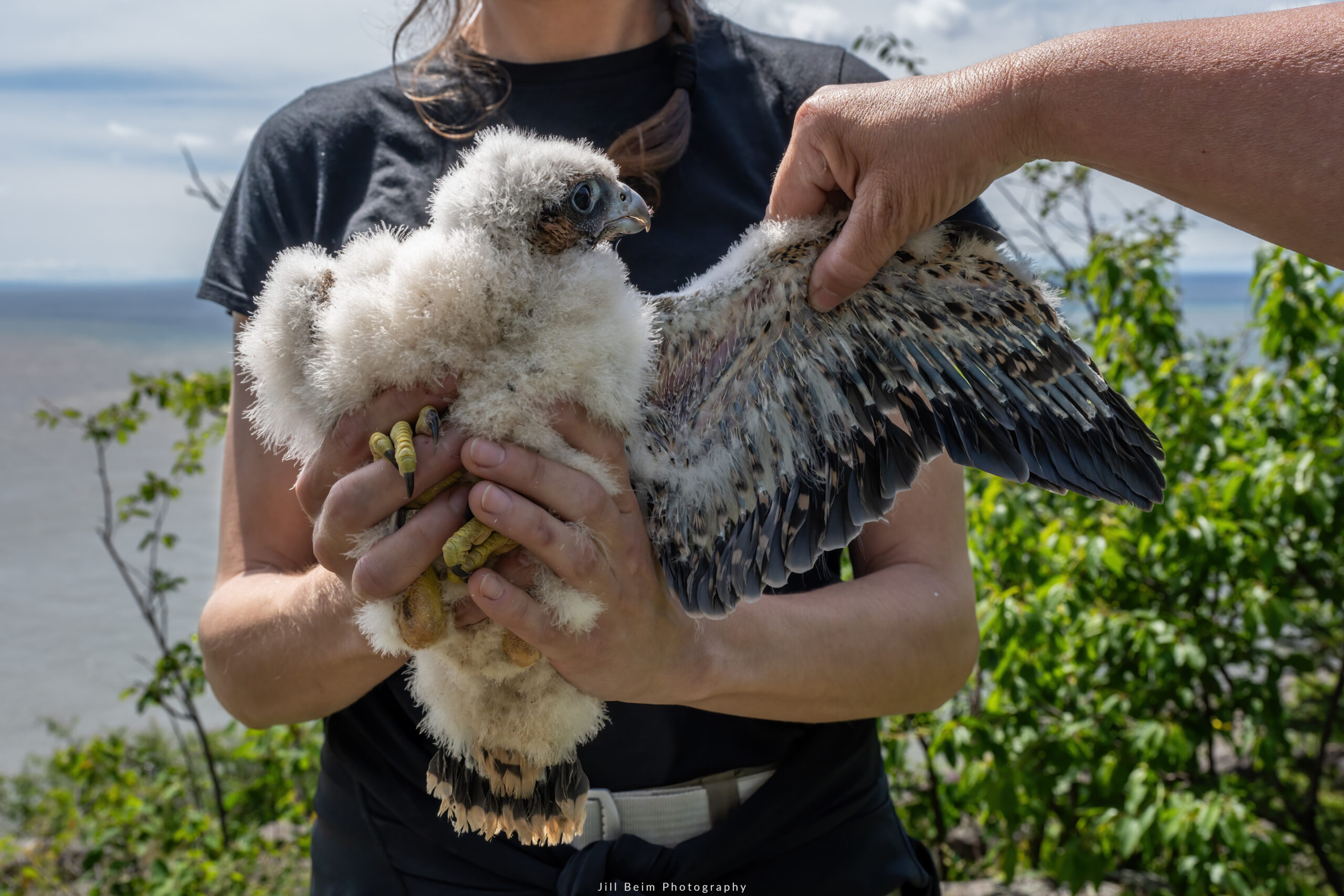
4 Weeks Old: Half-Feathered and Loud
At four weeks, the nest is bustling with activity. The chicks now sport a mix of speckled juvenile feathers and lingering tufts of down. This mottled look helps them blend into the nest. They’re loud, hungry, and vocal—especially when begging for food. Their wings appear longer and fuller as feathers continue to grow. The chicks often flap their wings and run across the nest surface. Over the next week, feather growth will accelerate, and the remaining down will fall away as they preen.
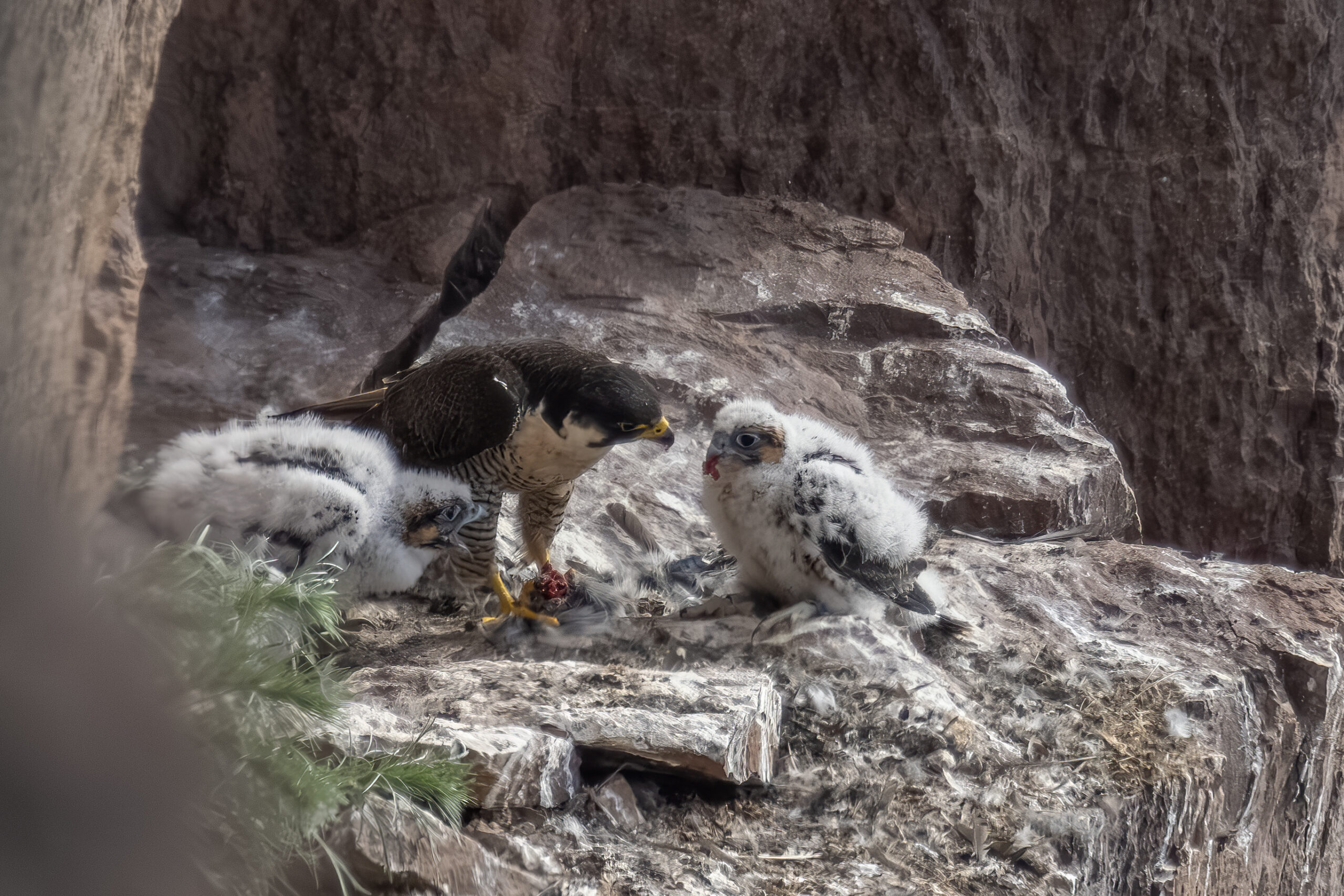
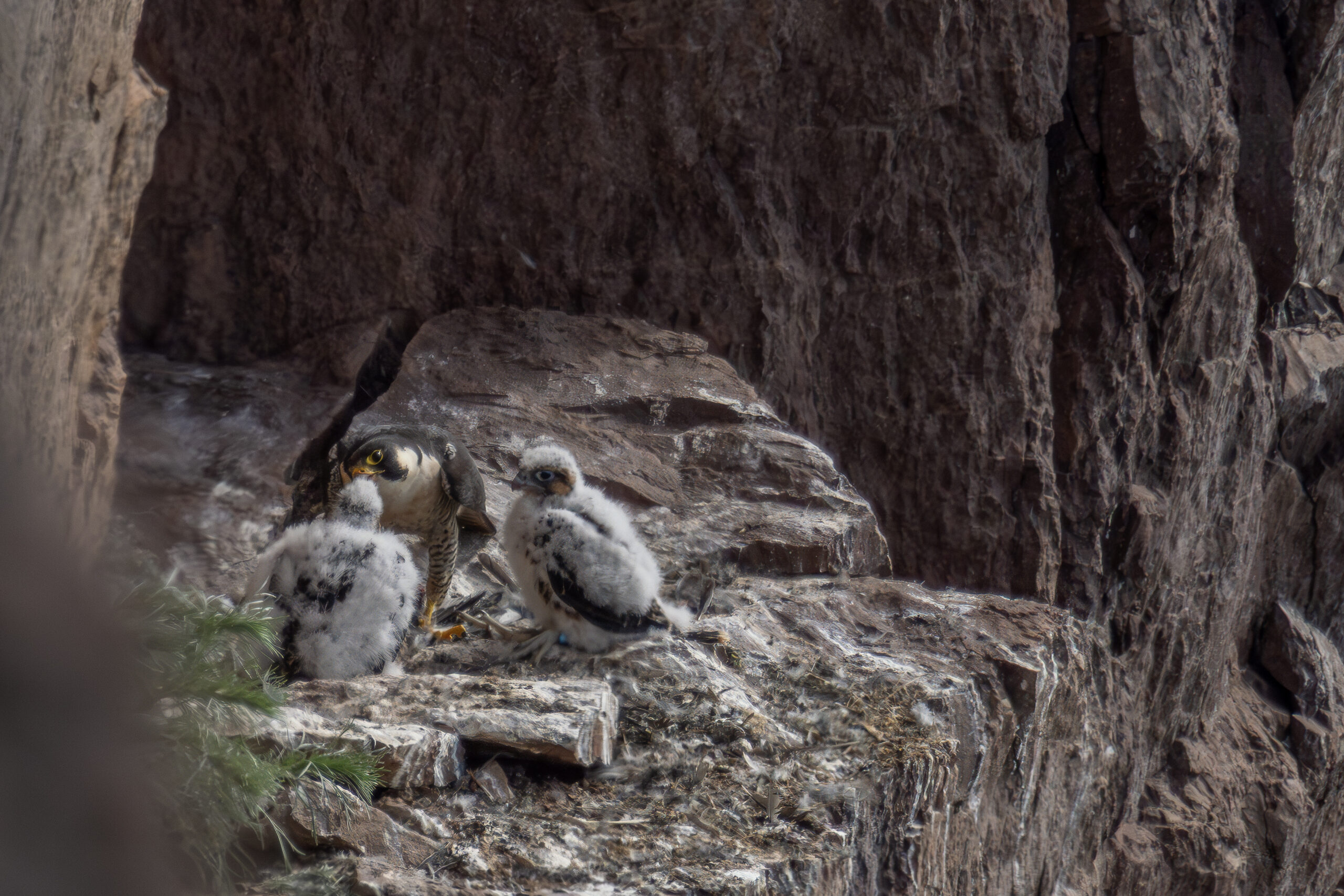
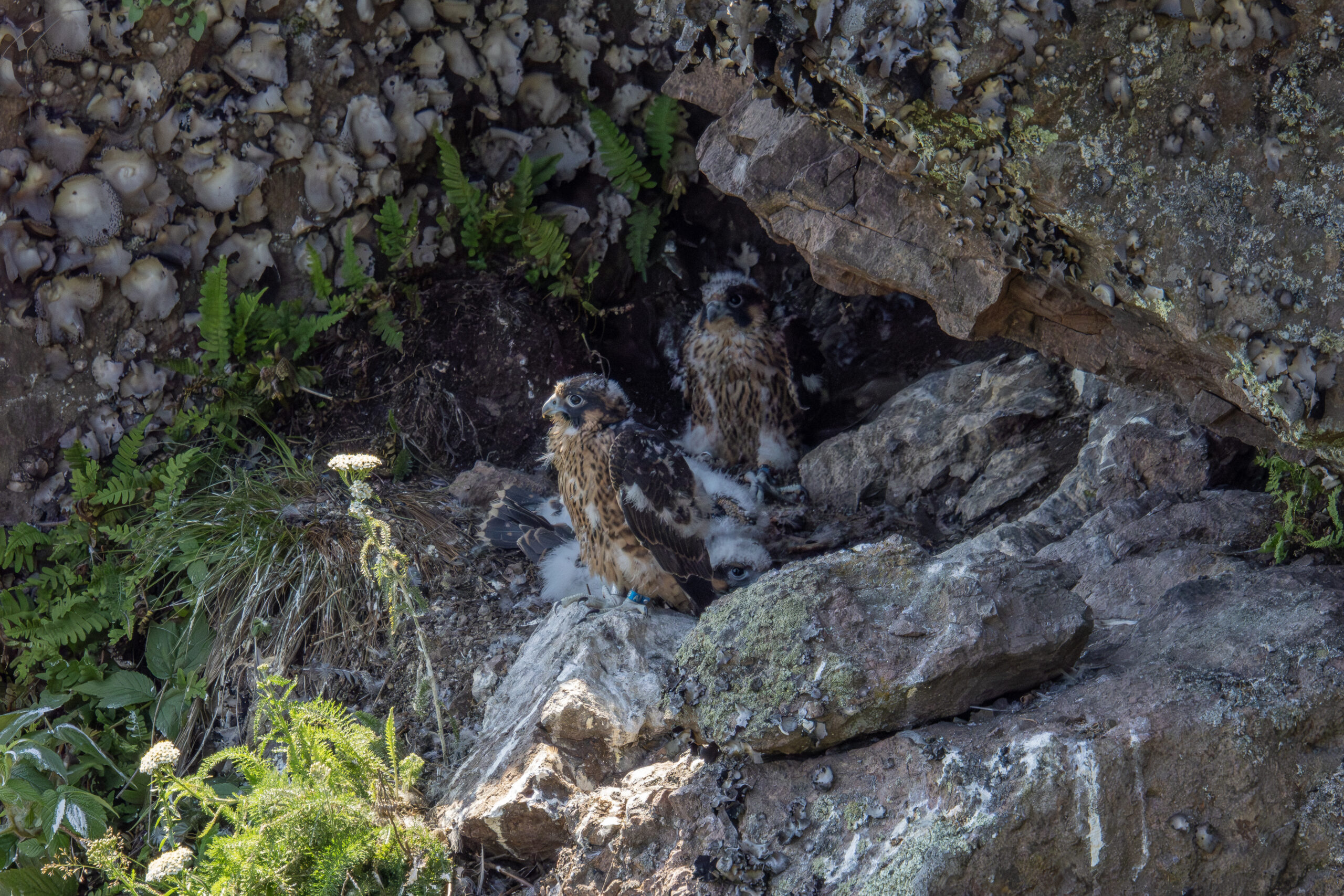
5 Weeks Old: Ledge Walking and Flapping
At this age, the chicks are covered in a mix of brown and cream feathers, with down lingering on their wings, heads, and “pantaloon” legs. They begin exploring the narrow cliff edges with wobbly steps, hops, and earnest flapping. Their growing tail feathers throw off their balance, often making them lean forward or stumble, while their wings help them stay upright or jump between rocks.
This stage is crucial for building strength and coordination. The chicks grip the ledge with their talons and flap vigorously, preparing their flight muscles for that first leap.
But life on the ledge is not without risk. A stray wingbeat from an enthusiastic sibling can accidentally knock a chick off the edge before it’s ready to fly. Premature falls are dangerous, as chicks may not yet be able to fly or cling to safety.
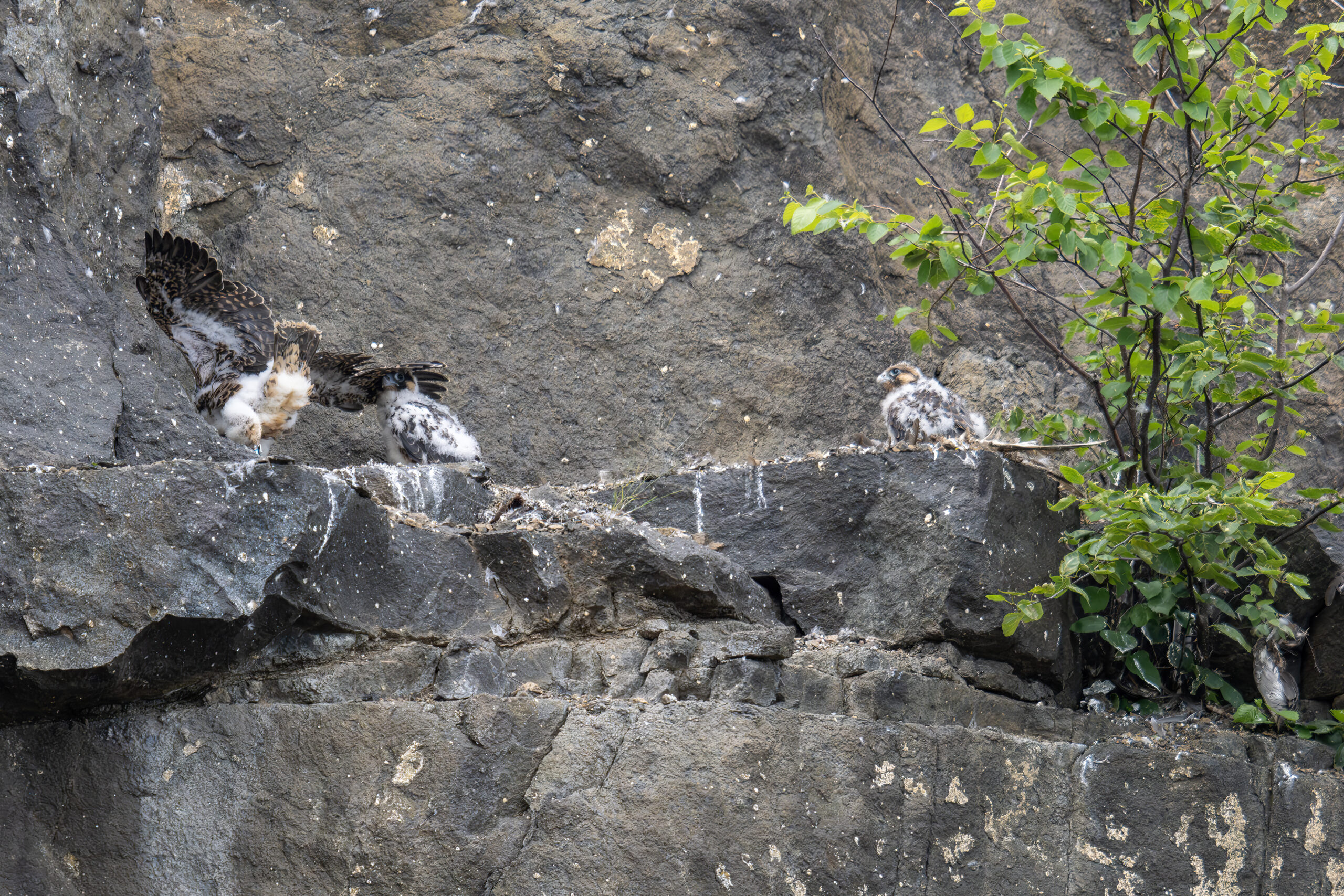
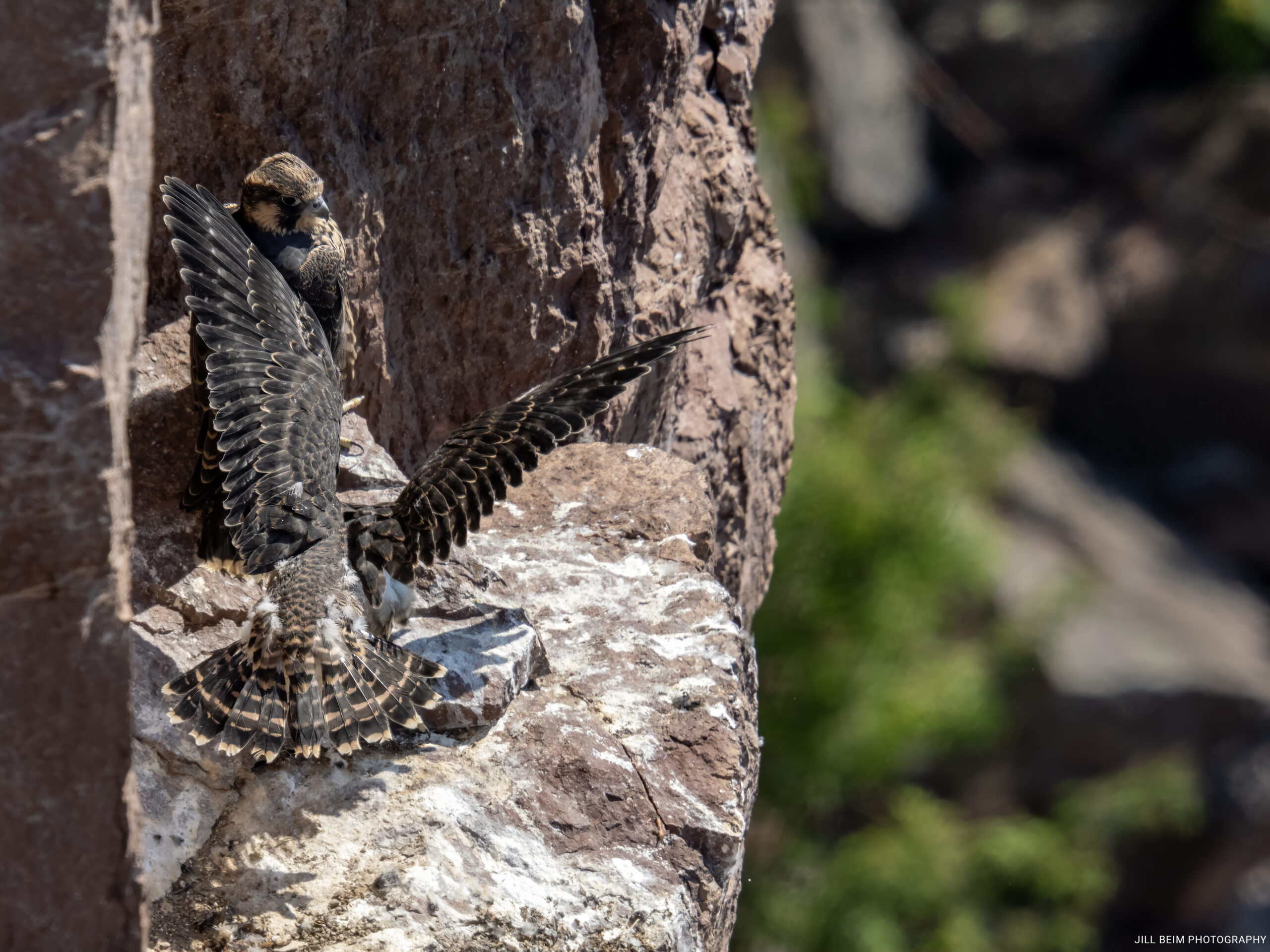
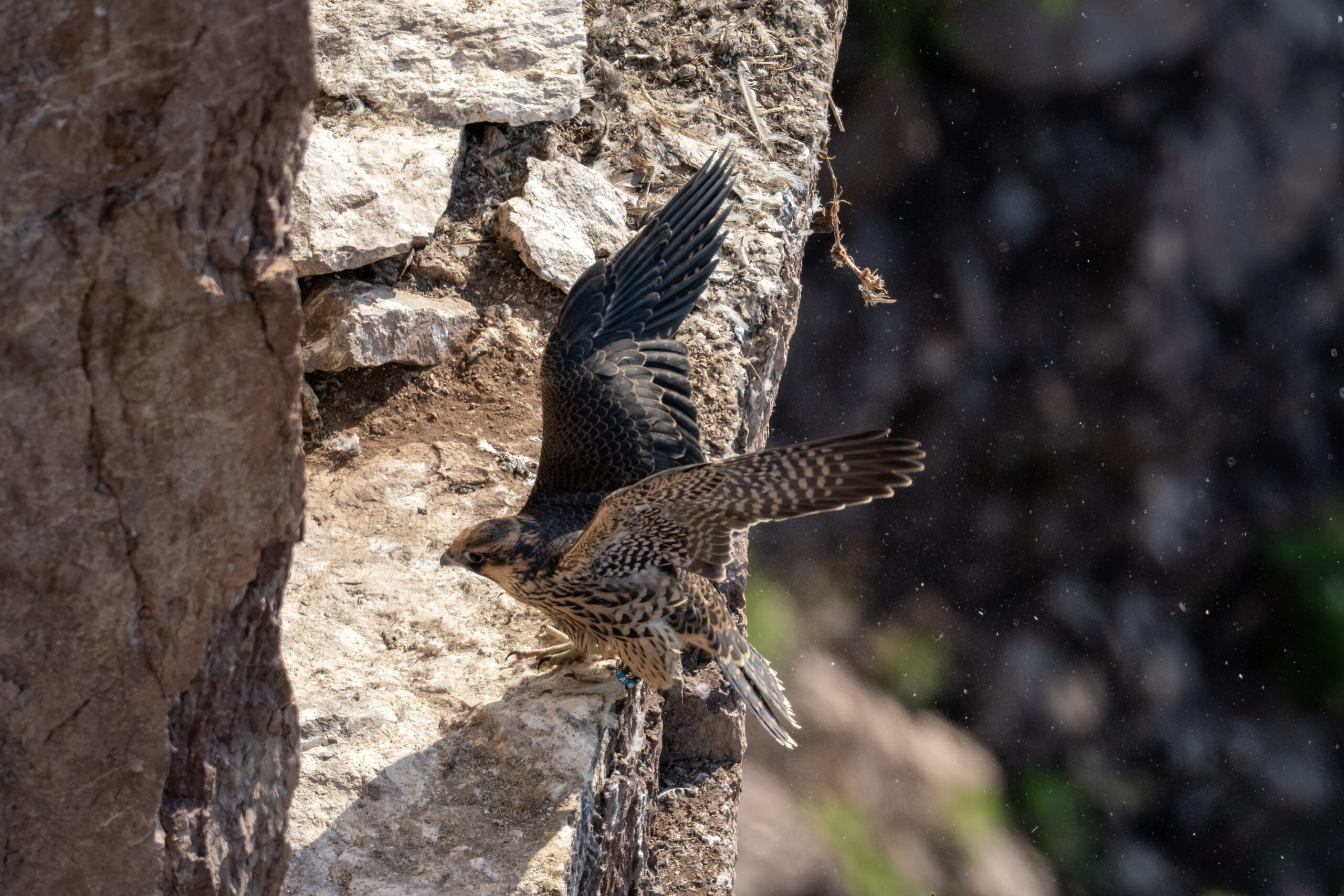
First Flight: Taking the Leap
By about 35 days old, the chicks are mostly feathered but still carry large patches of down on their legs, underwings, and the crown of their heads. A few days later, around 40 days, they are nearly fully feathered. Only traces of down remain on the crown, underwings, and the outer wing feathers, and their tail feathers aren’t fully grown—but by this point, they are capable of weak flight. Nestlings typically fledge sometime between 35 and 42 days.
During this stage, the chicks spend a week or more walking along the ledge, hopping and flapping as they test their wings and strengthen their muscles. The adults keep a watchful eye from above, sometimes offering food just out of reach or slightly reducing feedings. These interactions naturally encourage practice and growth, though they aren’t conscious “lessons”—just part of life on the cliff.
When a chick finally takes off, its first flight is often short and wobbly, but it’s a critical step toward independence. Each chick leaves on its own schedule, since they hatch a few days apart. Sometimes a chick intentionally leaves the ledge, but just as often, they fledge prematurely by accident—showing how risky and unpredictable that first flight can be.
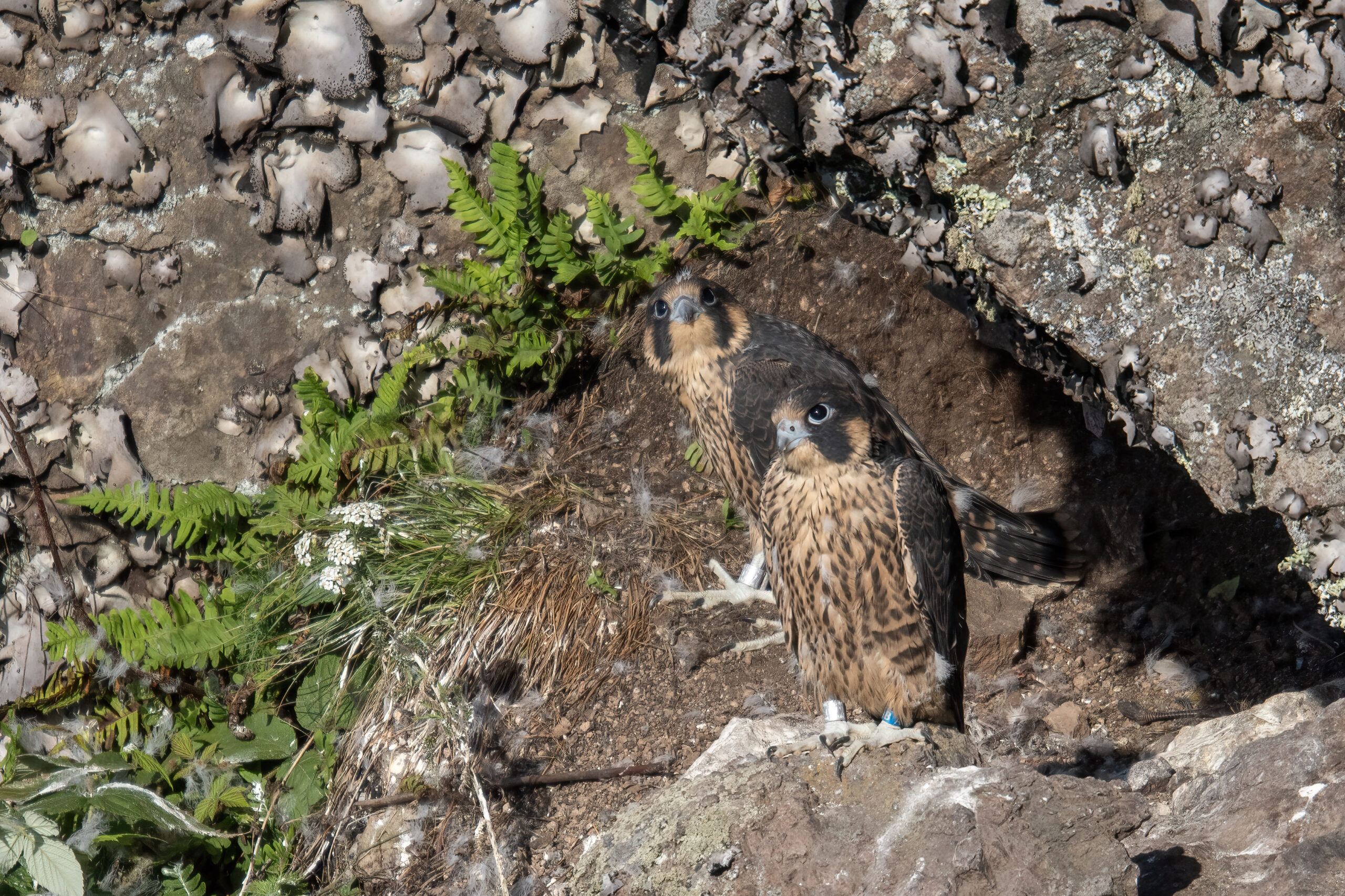
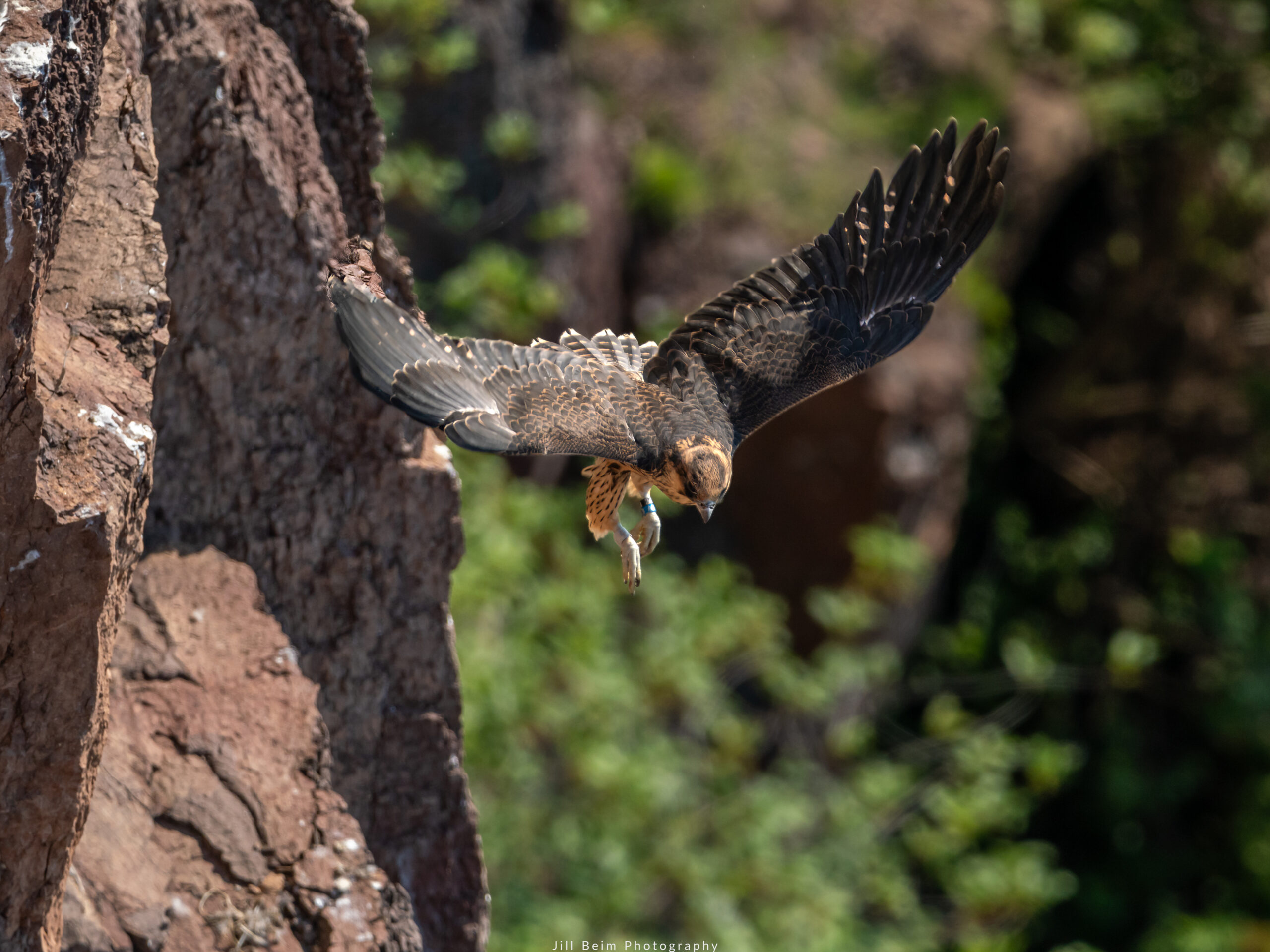
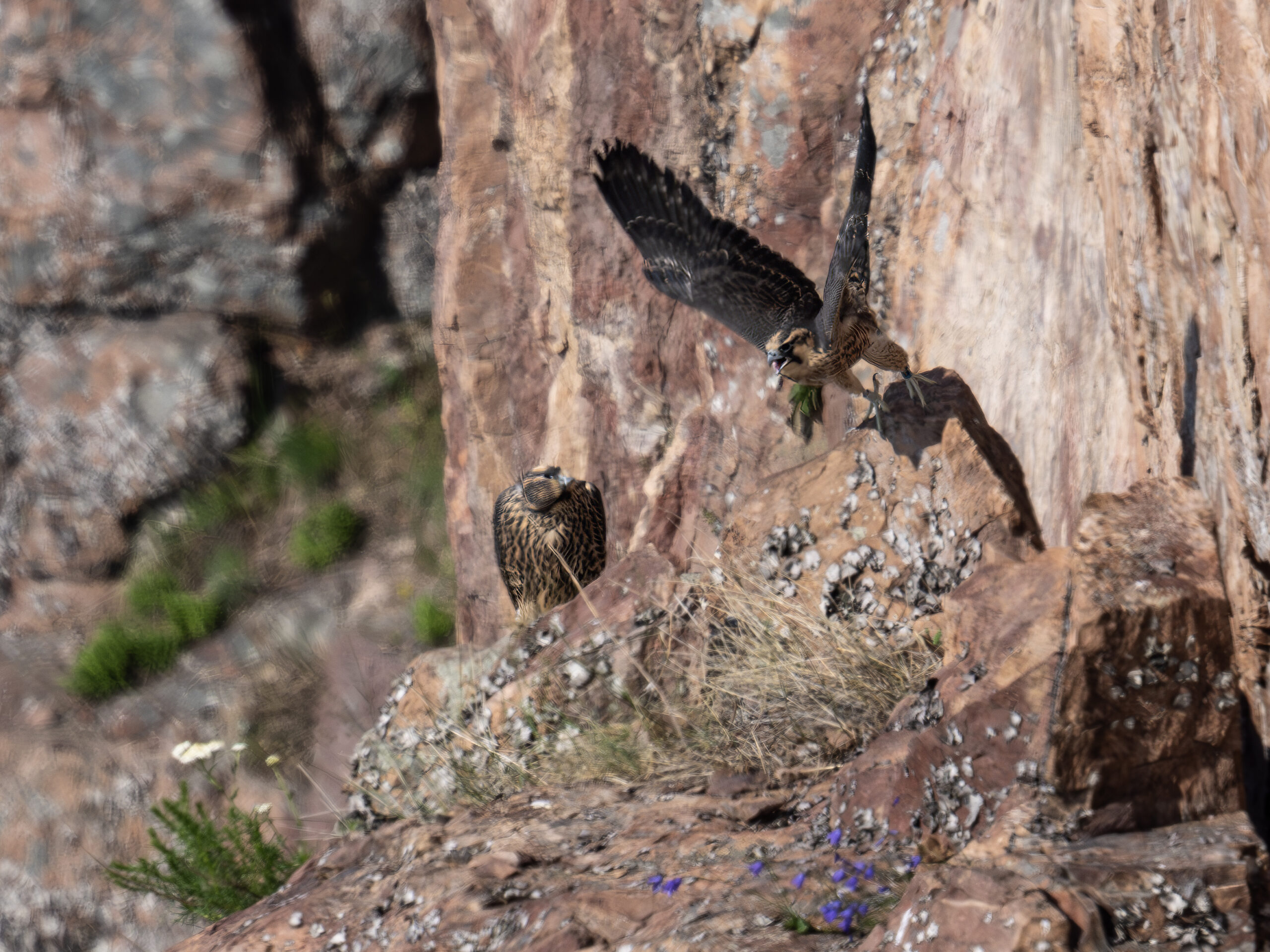
After Fledging: Lessons in the Sky
Even after fledging, young peregrine falcons remain closely tied to their parents for several weeks, relying on them for food for one to two months. Within ten days of their first flight, the fledglings begin actively pursuing their parents to solicit food—a behavior that dominates most of their activity during the first two weeks of flight.
Their flight develops in stages. In the first couple of days, they perform what researchers call Butterfly-Flight, a weaker form of flying marked by incomplete development of flight feathers and pectoral muscles. From days three to nine, they move into Flutter-Glide, and by roughly two to three weeks after first flight, most young are engaging in Powered Flight, able to sustain longer flights and range farther from the nest cliff.
During these early flights, the fledglings’ chases are accompanied by persistent begging vocalizations. They may even pursue their parents during territorial defense, showing just how single-minded their hunger can make them. In response, adults sometimes drop both dead and live birds midair, which the young pursue and catch. While this behavior has been interpreted as parental hunting training, it may also be simply a way for adults to avoid being mobbed by their hungry fledglings.
Fledglings often remain together with siblings for a month or more after leaving their natal territory, forming small sibling groups while they continue practicing flight and hunting skills. By about a month after fledging, most juveniles are capable hunters. Although they may continue to beg occasionally for a few more weeks, the parents gradually reduce food deliveries, nudging the young toward independence. Eventually, each fledgling grows restless and confident enough to strike out on a solo flight—and one day, it simply keeps going.
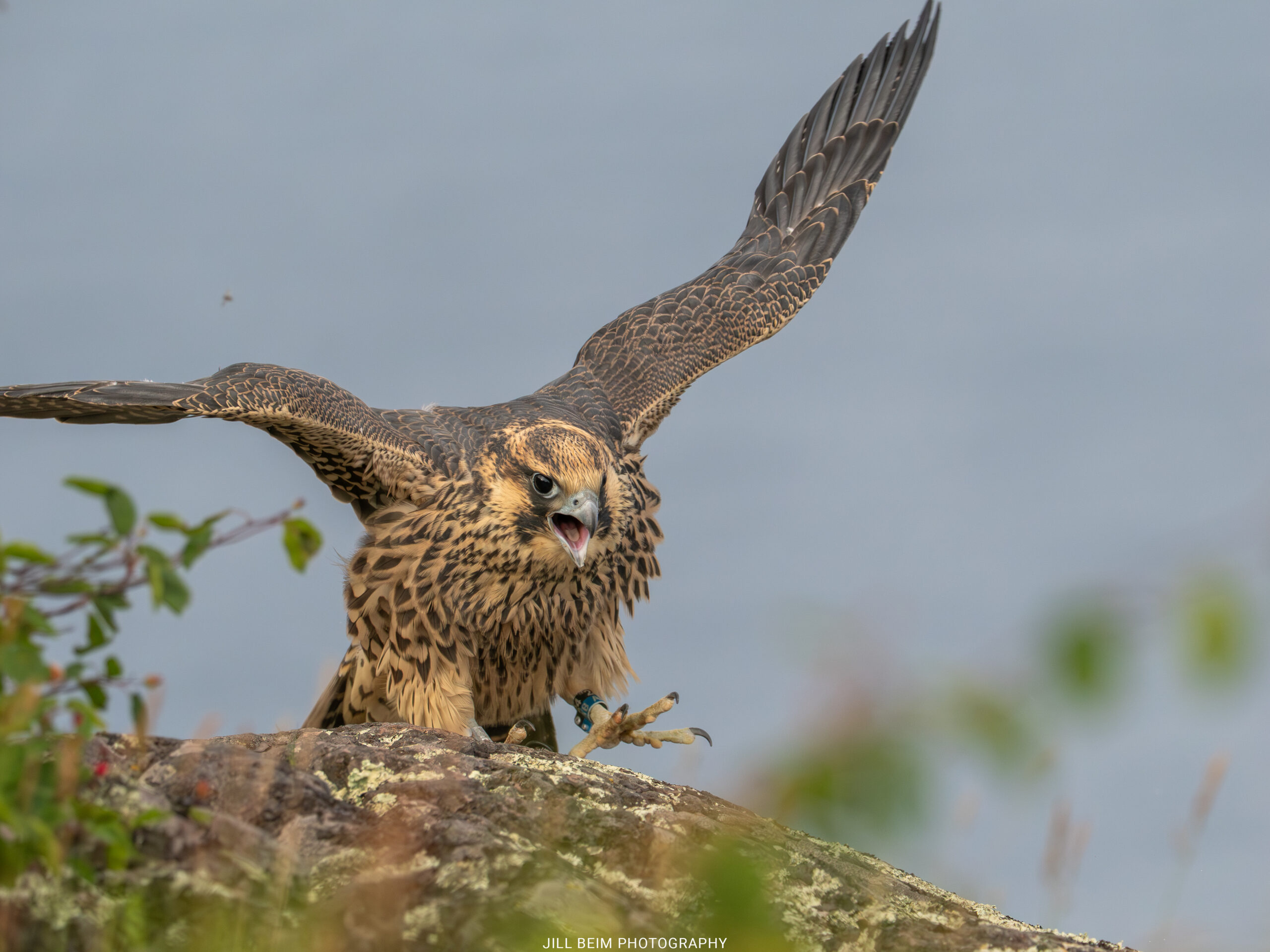
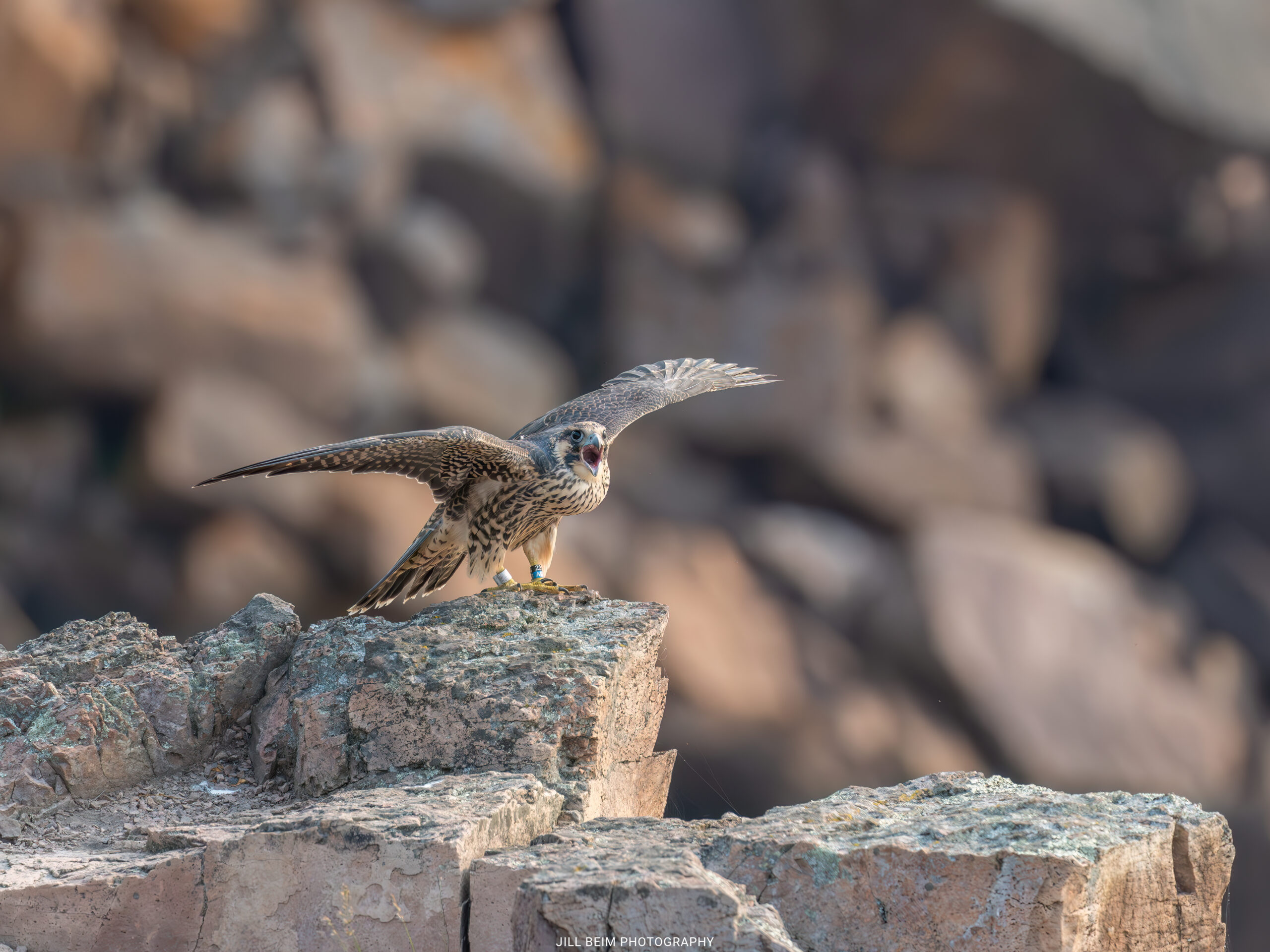
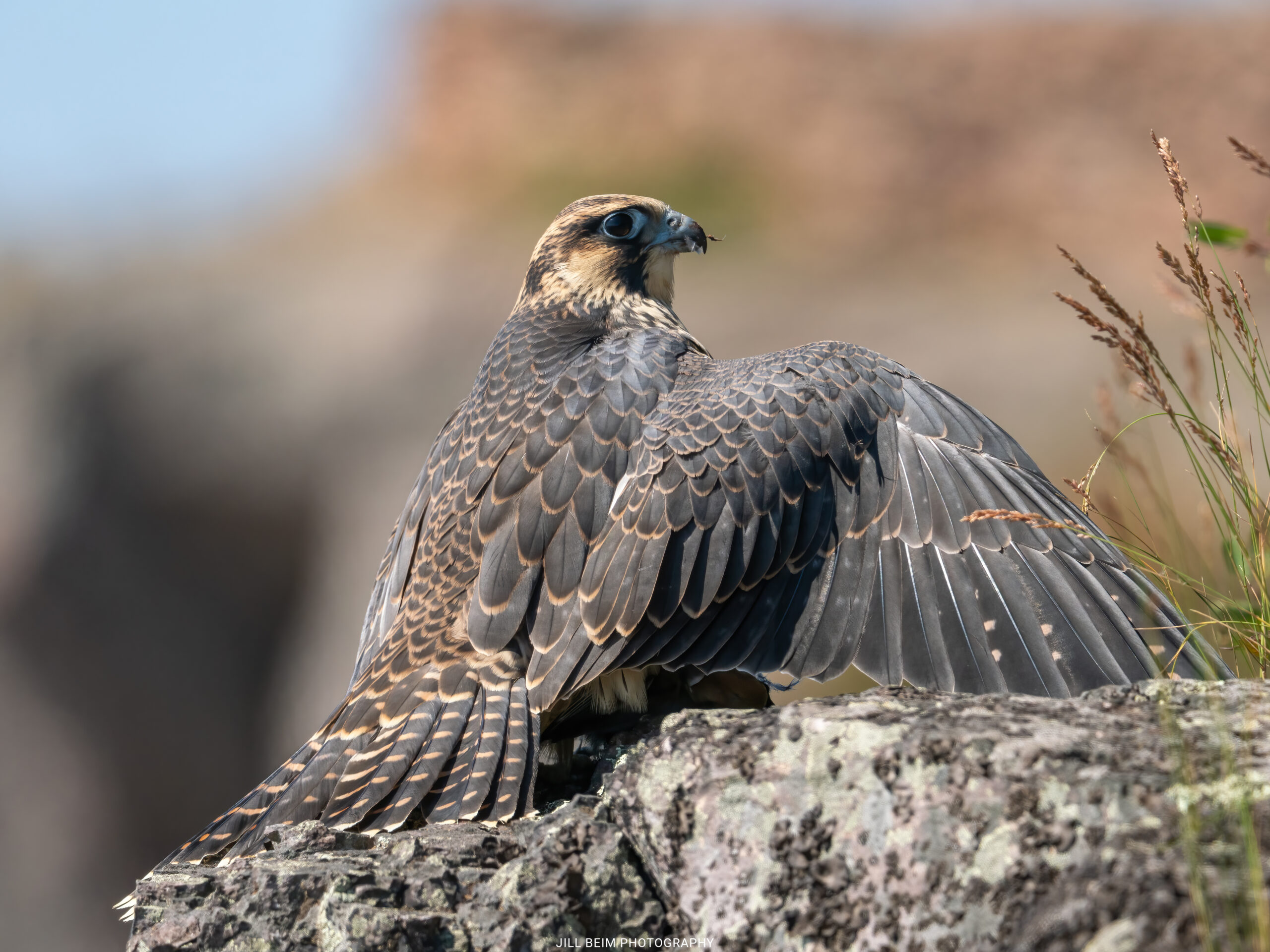
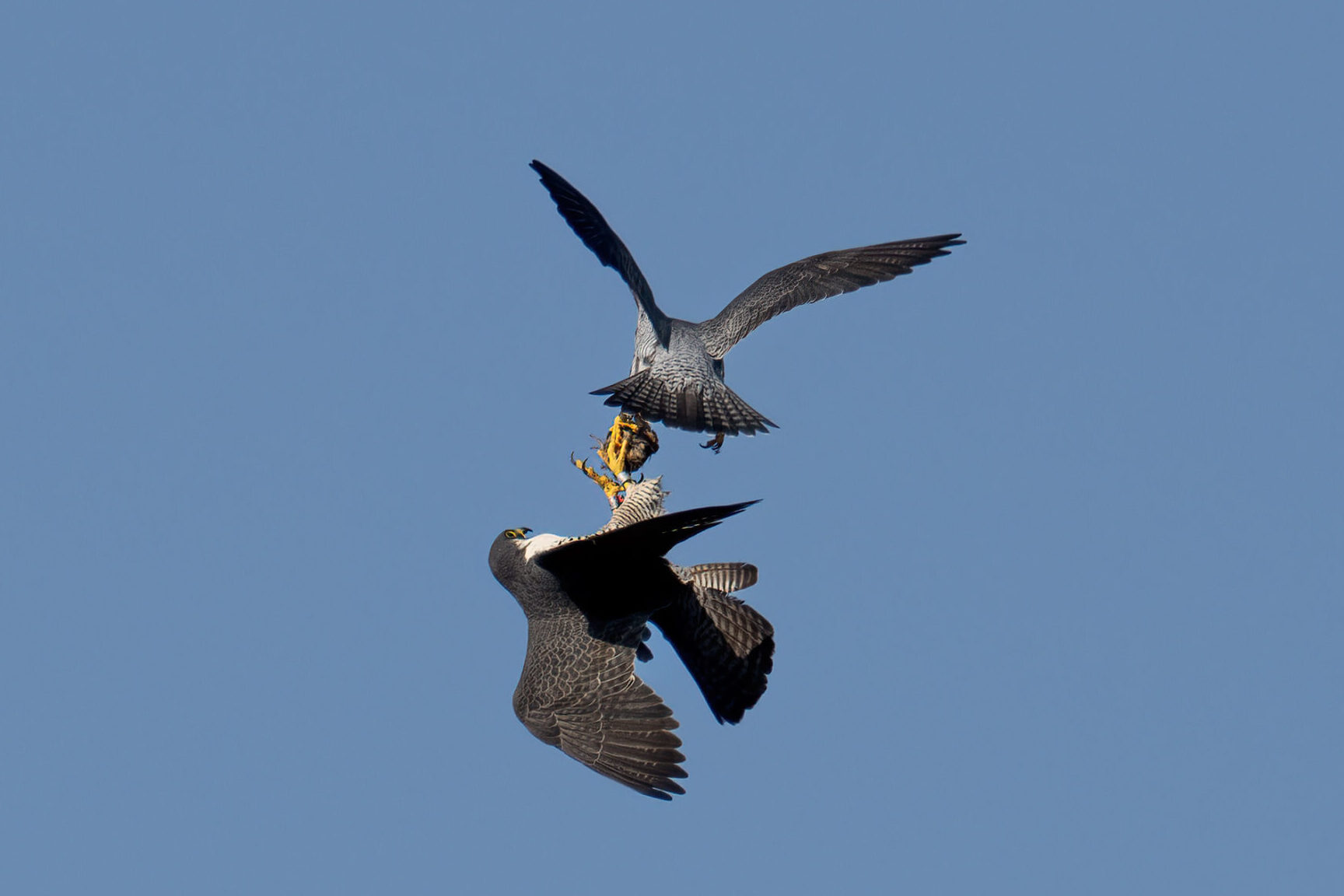
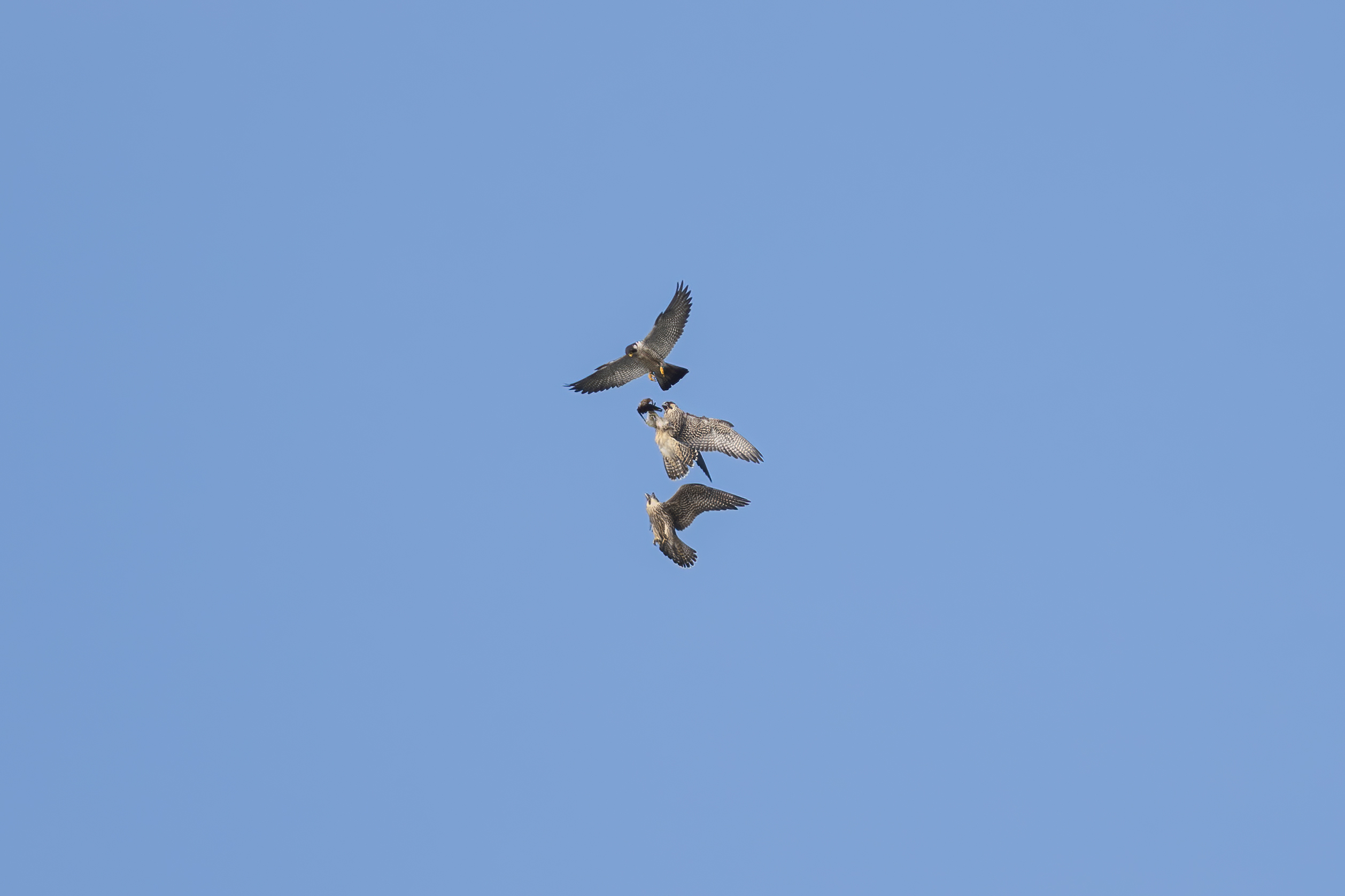
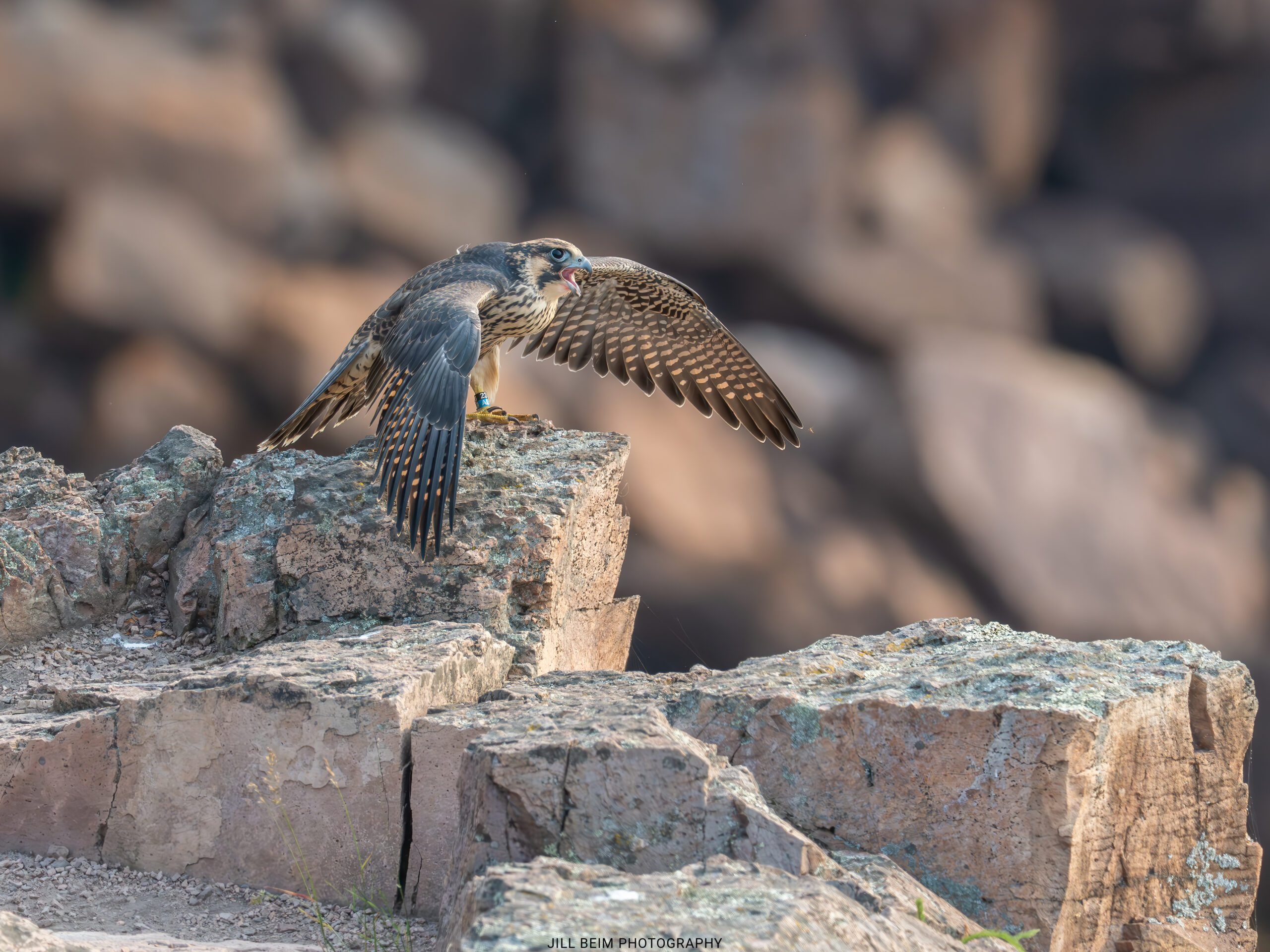
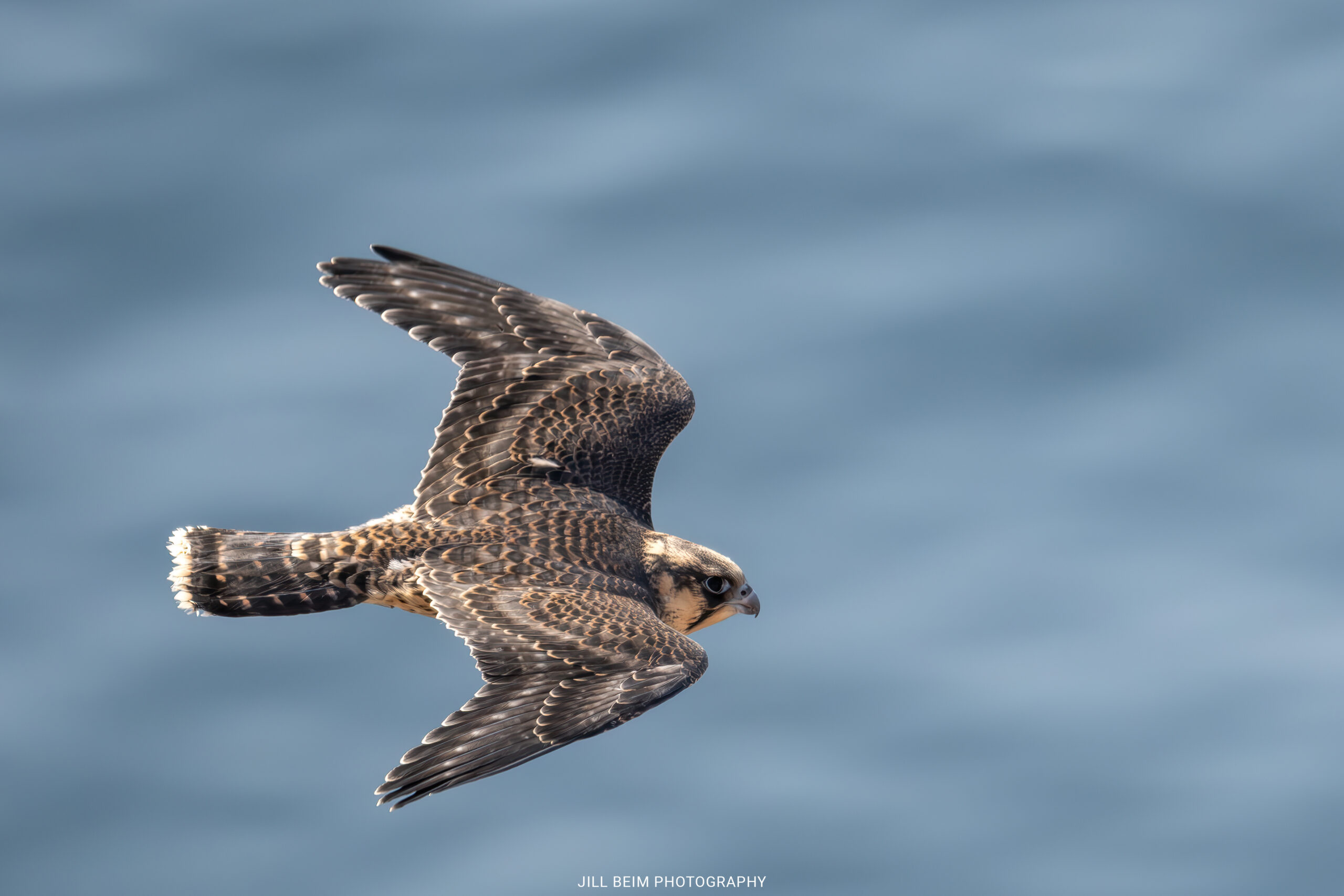
Wild and Free
Peregrine falcons were once nearly gone from this region. Today, thanks to decades of conservation efforts, they once again nest on the cliffs above Lake Superior—and soar wild and free.
